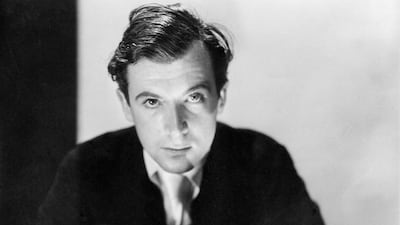Reclining and clutching a single rose with her sultry eyes staring into the camera, Marilyn Monroe draws in the viewer’s gaze.
Dressed in a strapless dress made of soft, white tulle, the star is lying on a bed at the Ambassador Hotel in New York. Although her expression is neutral, the emotion captured is intense.
The photograph was taken in 1956 and it was Monroe’s favourite of herself. The man behind the camera was Sir Cecil Beaton, the subject of the latest exhibition in Sotheby’s gallery space at Dubai International Financial Centre.
The English artist was perhaps best-known for his photographic portraits of celebrities during his prolific, six-decade career, which began in the 1920s and ended in the 1970s, before his death in 1980. Beaton was also an accomplished writer, painter and stage designer. He also won two Oscars for costume design, for the musicals Gigi (1958) and My Fair Lady (1964).
But a keen eye and congenial demeanour was Beaton’s trademark, allowing him to take stunning images of celebrities while empowering his subjects.
“Dearest C B, Ever since I can remember, I’ve always so badly wanted to be beautiful. Looking at those photographs last night, I saw that for a short time, at least, I am, all because of you,” wrote Audrey Hepburn after Beaton took her photograph. The quote is pasted in large letters next to an enlarged version of a portrait he took of her leaving a film set on her bicycle in Hollywood in 1963.
This image and so many others in the exhibition tell the story of the era. The portraits cover a good part of the 20th century and serve as a reflection of history, politics, fashion and celebrity.
This exhibition starts with a timeline of Beaton’s life, which is important to put his work into context.
“We want this exhibition to be educational,” says Joanna Ling, head of the Cecil Beaton Studio Archive in London, and co-curator of the show. “That way, it is not just a viewing but gives people a sense of Beaton’s broad-ranging life, because he was more than just a photographer.”
The lower floor of the gallery is dedicated to the 1920s, with the sumptuous fashion of the decade on full display in the photos alongside icons of the era.
Fred and Adele Astaire sit on a couch in a mirrored room in one image. Stephen Tennant – a British socialite and leading member of “the Bright Young Things”, a group of bohemian young aristocrats in London – poses for the camera in another.
Tennant introduced Beaton to high society and so his inclusion in this exhibition is important.
There are also several portraits of visual artists on display in the show, which is co-curated by Terence Pepper, curator of photographs at the National Portrait Gallery in London. Pablo Picasso, who Beaton photographed many times, is pictured here in 1933 with one of his paintings and a sculpture in the background.
Salvador Dali is pictured with his wife, Gala, wearing a fencing mask. From later years, David Hockney, Andy Warhol, Francis Bacon and Lucian Freud are also shown.
“Beaton, he was very clever and he seemed to sense who the leading lights of each era were and he photographed them,” says Ling.
The exhibition certainly acts like a who’s who of the 20th century.
Also on display are royals, including Queen Elizabeth II, pictured on her 16th birthday, and politicians – Winston Churchill is shown at his desk in 1940 during the Second World War – and ordinary people, too.
A portrait of injured 3-year-old Eileen Dunne, a victim of the Blitz, reportedly played a crucial role in getting the United States to join the Allied Forces.
Beaton himself appears in several of his images, tying his story inextricably to the characters in his work. As Ling suggests, when viewed as a whole, the exhibition reveals as much about his life and character as it does about his subjects.
As owners of The Cecil Beaton Studio Archive, Sotheby’s wanted to bring his work to Dubai to attract new interest, as well as educate audiences about his career.
“The whole objective of this space is to do more than promote our sales, we also want to add to the community,” says Katia Nounou, head of Sotheby’s Dubai office. “We want to educate people, bring children in and do plenty of workshops and other events.
“We also wanted to bring something really British from London for audiences here. People may not know much about Cecil Beaton, or relate to him, but they will certainly recognise the people he photographed, so that is where we can connect the dots and teach people about why he was so interesting.”
On Tuesday, there will be a presentation about Beaton’s life and work by Hugo Vickers, his biographer. There will also be a children’s event, organised under the newly signed Memorandum of Understanding with The Cultural Office of Sheikha Manal bint Mohammed bin Rashid Al Maktoum.
Although none of the photos in the exhibition are for sale, Sotheby’s is producing limited-edition platinum gelatin prints.
• The Cecil Beaton Portraits exhibition runs until May 27; 10am to 7pm Sunday to Thursday; 1pm to 8pm Saturday (closed Fridays and May 15, 16 and 20); Sotheby’s, DIFC, Dubai
aseaman@thenational.ae

